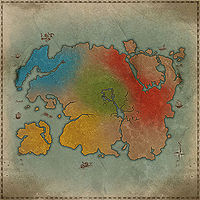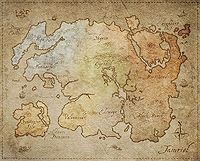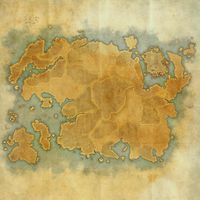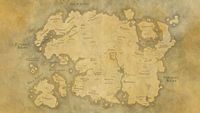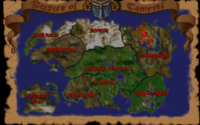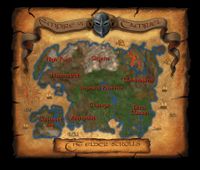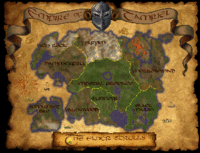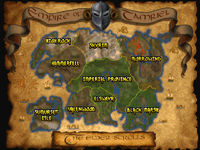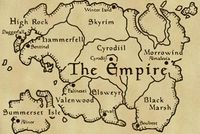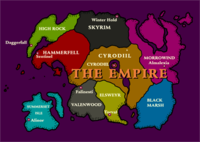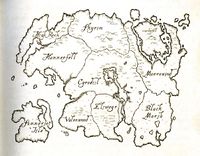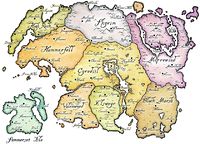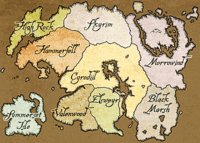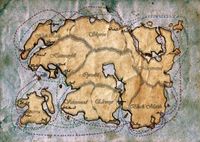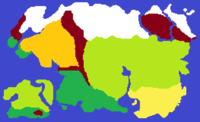Lore:Tamriel
| Tamriel | |
|---|---|
| Type | Continent |
| Continent | Tamriel |
| Demonym(s) | Tamrielan, Tamrielian, Tamrielic, Tamsfolk |
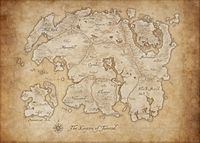
Tamriel, also known as the Arena, is one of the main continents of the planet Nirn.[1][UOL 1] This land is a great melting pot of cultures and races; being home to at least a dozen races, with dozens more having died out or changed in ages gone by.[2][3] The continent of Tamriel is divided into nine provinces, which have on occasion been united under the rule of the Empire.[4][5]
"Tamriel" itself is Elvish for Dawn's Beauty.[6] Though, the varying cultures have their own stylizations: the Ayleids name it Tamri-El,[7] the Marukhati call it Tam! Rugh!,[UOL 2] and the Dov entitled it Taazokaan.[8]
Bitter years of endless war had its effect on the populace, and the name Tamriel seldom fell from anguished lips. In a place where life and death were different sides of the same coin tossed every day, the common people began calling the land of their sorrow the Arena.[6][nb 1] This moniker is rooted in the metaphysics of the mundane plane itself, having been aboriginally born in titanic battles during the War of Manifest Metaphors,[9][10] and ever since being an eternally contested ground for mortal and immortal alike.[11] There have only been a few glorious brief moments in which the people of Tamriel stood united and victorious against a common enemy, such as the formation of the All Flags Navy during the Thrassian War and the Invasion of Coldharbour during the Planemeld.[12][13]
History[edit]
Much of Tamriel's history is known and documented, but large swathes are still unknown, particularly the periods known as the Dawn Era and the Merethic Era. Tamriel's very beginning can be traced to when the wandering Ehlnofey fought the Ehlnofey who remained settled in their former home. According to the narrative of the Anuad, the original singular landmass of Nirn was broken apart into at least four major landmasses—Tamriel, Akavir, Atmora, and Yokuda.[14] The wandering Ehlnofey were ancestors to all men, while the settled Ehlnofey were co-ancestors with the Aldmer to all mer. It was at the end of the Dawn Era that the Aldmer of Aldmeris began to diverge along cultural and biological lines, starting the process that would lead to the modern mer races.
In the middle of the Merethic Era an unknown threat caused the Aldmeri to leave Aldmeris and head towards Tamriel. They colonized many islands along its coast before settling on Summerset Isle. Later they started moving inland, settling many areas in southwest and central Tamriel. Wherever the Aldmer settled they displaced the primitive beastfolk (the ancestors of today's Argonians, etc.).[3] During this time the Ayleids built White-Gold Tower and eight lesser towers around it.[15] Through powerful machinations and the position as the 'spoke' of the wheel within the lesser towers, White-Gold Tower became a very powerful tool—it is said that the tower is what stops Mundus falling back into Oblivion.[16]
Traditionally, the late Merethic Era is the time that men begin to appear on Tamriel.[2] This is not strictly true, as many races of men—such as the feathered men that Topal the Pilot encountered, or a human race in Morrowind—already resided on Tamriel.[17][2] Instead this time is taken as the period when the men of Atmora came in force to occupy and settle whole-scale on Tamriel.[2] These Atmorans were the ancestors of the Nords. While many of the original races of men died out, many of them interbred enough to become one race known as the Imperials.[18] The conquering of northern Tamriel was sparked by the decline of Atmora and its eventual loss to a catastrophic change of climate from one that supported life to one of 'permanent winter' where no life could survive for long.[19]
The Dragon War at the end of the Merethic Era ended the reign of the Dragons.[20] In the third century of the First Era the Alessian Slave Rebellion saw the humans of Cyrodiil overthrow their slavers, the Ayleids, marking the point at which humans began to dominate Tamrielic history.[21] St. Alessia made a covenant with Akatosh to create the Amulet of Kings. The covenant stated that so long as one of Alessia's heirs wore the amulet, the realms of Oblivion would be cut off from Nirn.[22]
Near the end of the seventh century, in 1E 668, Red Mountain erupted for the first time in recorded history. 32 years later the Battle of Red Mountain occurred, in which the Chimer fought the Dwemer on Vvardenfell. The end of the war came when all Dwemer simply vanished from Tamriel, leaving behind their many artifacts and strongholds. After the war the Tribunal took over Morrowind, and shortly after that the Chimer were changed into the Dunmer.[23]
The continent of Yokuda sank in 1E 792, so its peoples, the Yokudans, emigrated to the area now known as Hammerfell.[19] The nature of the disaster is unknown but many natives think it was self-inflicted.[24] The Yokudans, after conquering Hammerfell, took on many of the customs of the Ayleids, and after many centuries in the harsh desert conditions evolved into modern day Redguards.
In 1E 2200 the Thrassian Plague claimed the lives of more than half of Tamriel's population. The losses were concentrated to the west and south. The plague was particularly hard on the Khajiit of Elsweyr. From sixteen harmonious kingdoms and twenty different types of Khajiit, the plague left them with catpower to form only two kingdoms. The often vastly different outlooks from the various kingdoms all shoved together led to conflict.[25] In response to the Plague the All-Flags Navy was formed to exact revenge on the Sload. This was the first time all nations on Tamriel had worked together and it would have profound implications that would last for eras. In 1E 2703 the Tsaesci from Akavir invaded Tamriel. Skyrim and Cyrodiil united to defeat them. The leader of the armies, Reman, went on to found the Second Empire, which brought all the nations of Tamriel, except Morrowind, under the Empire's control as provinces until 2E 430.[19]
In 2E 560 the Knahaten Flu spread from Black Marsh through the lower provinces and then into the other provinces killing many people. Argonians were immune to the disease, leading to speculation they were responsible, but this proved to be incorrect. While the disease killed almost all non-Argonians in Black Marsh it was not as devastating elsewhere, though it did wipe out entire cities, religions, and cultures.[26] The Knahaten Flu had a big impact on events of the next three decades. The Altmer gave aid to the suffering Khajiit, who out of gratitude joined the Aldmeri Dominion. The ruling family of Wayrest was wiped out, leading to Emeric becoming king. Emeric spent the next fifteen years expanding the newly signed Daggerfall Covenant to include High Rock's neighbors in Hammerfell and Orsinium. The Argonians then banded together, as an equal partner, with the Nords and Dunmer in the Ebonheart Pact, to protect their interests against the other two alliances.[27]
In 2E 582 the Alliance War broke out. Tensions had been simmering between the three alliances and the Empire of Cyrodiil, but the Soulburst and the Planemeld threw them into open conflict to try and gain control of the Ruby Throne and save Nirn from Molag Bal. Molag Bal's plan was foiled but the outcome of the war for the throne is unknown.[28] From 2E 852 to 854 a series of wars led by Cuhlecain and Tiber Septim led to the formation of the Third Empire under Tiber's rule. In 2E 896 Tiber conquered the Summerset Isles and for the first time all the provinces of Tamriel were united under one banner. The significance of the event led Tiber to declare a new era.[29]
In 3E 433 the Oblivion Crisis occurred. Due to a lack of Alessian heirs to wear the Amulet of Kings, the Dragonfires died out. Mehrunes Dagon attempted to invade Tamriel, destroying Kvatch and the Crystal Tower. The Crisis ended when an illegitimate heir sacrificed himself to call Akatosh and defeat Dagon.[30] It was claimed that Nirn could not ever be invaded again by daedra from Oblivion. When the Crisis was over a new era was announced, making the Third Era the shortest complete era to date.
At the start of the Fourth Era Red Mountain erupted again. This time it destroyed the entire island and devastated the rest of Morrowind. The Argonians then invaded and unleashed their anger at centuries of oppression and slavery on the survivors, only being stopped on the banks of the Scathing Bay.[31] During the early Fourth Era the Empire started to crumble and then in 4E 48 Umbriel, a floating island from Oblivion appeared. The island made its way over Black Marsh to Morrowind, before turning and heading straight for the White-Gold Tower, causing massive devastation along the way. The island was summoned by a rogue Hist tree to kill all non-native Argonians, but quickly went its own way after appearing. The island was eventually stopped by the efforts of Prince Attrebus Mede and Annaïg Hoïnart. It disappeared leaving behind hordes of corpses by the walls of the Imperial City.[16]
From 4E 171 to 175 the Great War between the Thalmor and the remainder of the Empire raged across Tamriel. The Thalmor leaders of the third Aldmeri Dominion, believed that mer should rule the continent, while the men who currently occupy the throne think different. The terms of the current peace treaty drove Hammerfell to abandon the Empire, and a civil war broke out in Skyrim—the result of which will determine if Skyrim will also secede.[32]
Provinces[edit]
There are nine distinct provinces, each home to one of the more populous races of Tamriel. A proposed tenth province, Orsinium, has never been taken very seriously except by those who want it, namely the Orcs, who wish to have a home province of their own.[33]
Cyrodiil[edit]
Cyrodiil, also known as the Imperial Province, Dragon Empire, Starry Heart of Nirn, and Seat of Sundered Kings, and Cyrod in Ayleidoon, is a province in south-central Tamriel that is home to the human race known as Imperials. The center of their empire and seat of governance, Cyrodiil is also known as "the Heartland". The capital of both Cyrodiil and the empire, the Imperial City, is located on City Isle in the center of the province; at the heart of the city is White-Gold Tower, possibly the most renowned monument in Tamriel. Despite some accounts describing Cyrodiil as a jungle, it has a primarily temperate climate. One scholar of the middle Second Era attributed this discrepancy to errors made during the transcription of historical texts, while another speculated that White-Gold Tower itself adapted the climate to suit the region's inhabitants. Later sources asserted that Emperor Tiber Septim altered Cyrodiil's climate after he united all the provinces under his rule.
Black Marsh[edit]
Black Marsh is a dense swampland region of southeastern Tamriel, home to the reptilian humanoid race of Argonians and a race of sapient trees known as the Hist. Mer refer to the region as Argonia, named after an ancient battlefield. The Argonians do not have a word for their homeland in their native language, in part because they do not consider it a singular nation. A member of the Argonian Gee-Rusleel tribe once used the wide-swamp gesture alongside the word kronka-thatith (roughly meaning "everything-egg") to describe the region, which is probably the closest non-Jel speakers will ever get in the way of a "true name" for the region. Many Argonians who live there struggle with the concept of it being a "province", as there is so much varied difference in each part of Black Marsh.
The Argonians thrive in the foreboding swamps of Black Marsh, a lush and threatening land teeming with poisonous plants and violent predators. The region's tropical climate lends its plants the capacity to overturn all attempts to cultivate them. Foreign agricultural, colonial, and commercial ventures beyond the slave-trade have met with abject failure. The native Argonians organize themselves on the tribal level with success and efficiency, and were only loosely integrated into the ruling Empire when Cyrodiilic Emperors deigned to lay claim to the land.
Aside from the Argonians, Black Marsh is host to a slew of other sapient peoples. The human inhabitants of Black Marsh (Imperial settlers from the Cyrodiilic Empire notwithstanding) include the Horwalli, the Yespest, and the silver-skinned Kothringi. The Orma, who are predisposed to blindness, are another Mannish race that inhabits the marsh. The serpent-bodied Lamias and the vulpine Lilmothiit (the latter of which lived along the southern coasts) are notable instances of humanoid and semi-humanoid races that live in the region. The Kothringi and the Lilmothiit were driven to extinction by the Knahaten Flu.
For more information, see the main lore article.
Elsweyr[edit]
Elsweyr is a region that lies on the southern coast of Tamriel, and is home to the feline Khajiit. It is divided into two major climates: savannahs, badlands and dry plains in the north, and fertile lands of jungle and rainforests in the south.
Originally, sixteen Khajiiti clans roamed the province, and were often simplified as belonging to a region or realm. With a combination of outside pressures and mastery of areas of expertise, it became more accurate to associate a clan with an area. Eventually, sixteen tribes became sixteen kingdoms: Ne-Quin-Al, Rimmen, Riverhold, Dune, Orcrest, Verkarth, Meirvale, and Helkarn in the north; Alabaster, Bruk'ra, Pa'alatiin, Corinthe, Tenmar, Torval, Khenarthia, and Senchal in the south. The lullaby known as the Hasa Zha'ja explains how these clans got their name, while the poem known as Zhan Zhab tells of the transition from clan names being used to refer to the names of regions. Due to the Thrassian Plague, these sixteen clans changed their tribal functions or they may have died due to starvation and other hardships. These clans essentially became two and were separated ideologically and geographically as what we would come to know as the two kingdoms of Anequina and Pellitine. These two kingdoms would eventually be united into the Elsweyr Confederacy, and once more separated in two kingdoms in the Third Aldmeri Dominion.
Hammerfell[edit]
Hammerfell, once known as Hegathe, the Deathland (or Deathlands), and Volenfell, is a region in the west of Tamriel. It has been described as a province, kingdom, or republic throughout its history. Situated between Skyrim, Cyrodiil, and High Rock, Hammerfell features diverse landscapes including beaches, jungles, grasslands, mountains, and the vast Alik'r desert. It is inhabited by the human race of Redguards, who migrated to Tamriel following the partial sinking of their homeland, Yokuda.
High Rock[edit]
High Rock is a province in northwestern Tamriel. Most of the province is inhabited by the Bretons, who have divided the province into multiple Breton city states and minor kingdoms. High Rock has also historically contained Orsinium, the City-State of the Orcs. High Rock encompasses the many lands and clans of Greater Bretony, the Dellese Isles, the Bjoulsae River tribes, and, by tradition, the Western Reach. The Direnni once controlled the entire province until the dissolution of their Hegemony in the First Era, leaving behind many ruins and a lasting legacy on the newly formed Breton city-states in their wake. The rugged highland strongholds and isolated valley settlements have encouraged the fierce independence of the various local Breton clans, resisting integration into a formal province or Imperial identity. Nonetheless, their language, bardic traditions, and heroic legends are a unifying legacy. Aside from the Bretons and their ancestors, other races that have inhabited the province include centaurs, giants, goblins, Orcs, and Snow Elves.
Morrowind[edit]
Morrowind, previously named Dwemereth, Veloth, Resdayn, Resdaynia, and Dunmereth, and also known as the Land of Ash, is the nation in the northeast corner of Tamriel, and the home of the Dunmer. It is dominated by the large island of Vvardenfell and its centerpiece, the ash-spewing Red Mountain, but also includes territory on the continental mainland. The Inner Sea separates Vvardenfell from the mainland, and the Sea of Ghosts lies to the region's north and east. Solstheim, an island in this sea near northwestern Morrowind, has not traditionally been associated with any particular province, though Morrowind had long maintained a theoretical claim to it. The Nords of Skyrim conceded the island to Morrowind in 4E 16 following the Red Year, allowing the Dunmer to settle it without contest.
Skyrim[edit]
Skyrim, the northernmost province of Tamriel, is a cold and mountainous region also known as the Old Kingdom, Mereth, or the Fatherland, or Keizaal in the dragon tongue. Many past battles have given it a ravaged appearance and many ruins. Though currently inhabited primarily by Nords, the Elves who they replaced had resided there since time immemorial. The sovereign, the High King of Skyrim, is chosen by the Moot, a convention of jarls. A jarl is a regional ruler chosen through heredity and, rarely, through right of arms. The High King typically rules until death, though acts of dishonor, particularly the appearance of cowardice, can lead to the recall and reconsideration of the Moot. Since the Pact of Chieftains was signed in 1E 420, the Moot does not give serious consideration to anyone but the High King's direct heir unless one is not available.
For more information, see the main Lore article.
Summerset Isles[edit]
The Summerset Isles (sometimes spelled Sumurset, Summurset or Sumerset),[nb 1] officially named Alinor since 4E 22, is a province in southwest Tamriel consisting of fourteen islands of varying size. The three largest and most significant islands are Summerset Isle, Auridon, and Artaeum, the latter of which is apt to disappear for sizable lengths of time without warning. It was settled and ruled under the Kingdom of Alinor in ancient times, but in 4E 22, the Thalmor seized power and renamed the province after its capital, Alinor, though many outside the province still refer to it as Summerset. The current inhabitants of the province are the Altmer, though goblins were there when the elves first arrived. It is believed that the first inhabitants were the Sload before they were driven away by the Aldmer, whom the Altmer claim to be directly descended from.
Valenwood[edit]
Valenwood is a densely forested, sub-tropical region that encompasses the southwestern coastal plain of Tamriel. In the words of A Pocket Guide to the Empire, Valenwood is "a sea of endless green, a maze of foliage with half-hidden cities growing like blooms from a flower, the home of the Bosmer is Tamriel's garden." Alongside the Wood Elves, races like the Wood Orcs, Imga, and Centaur also call the forest their home. One unusual feature of Valenwood is its gigantic, migratory trees, many so large that the Bosmer have built entire cities in their branches. Falinesti is one such tree, a mile-high specimen that serves as the capital of Valenwood and seat of its kings. The forest is often referred to by Bosmer as 'the Valenwood', designating the province as an entity in its own right.
Gallery[edit]
-
Tamriel, 2E 582
(ESO Alliance War territories) -
Tamriel, 2E 864
(Pocket Guide to the Empire, 1st Edition) -
The Empire of Tamriel, 3E 389
(Arena) -
The Empire of Tamriel, 3E 389
(Arena Deluxe Edition) -
The Empire of Tamriel, 3E 405
(Daggerfall) -
The Empire of Tamriel, 3E 405
(Daggerfall) -
Tamriel, circa 3E 427
(Morrowind) -
Tamriel, 3E 432
(Pocket Guide to the Empire, 3rd Edition) -
Tamriel, circa 3E 433
(Elder Scrolls Codex) -
East Empire Company Shipping Map, 4E 201
(Skyrim)
Notes[edit]
- When asked about who designed the Tamriel map, the original developers had this to say:
- Vijay Lakshman: That is crazy as a question, ultimately because there's so many people who touch the map as you end up getting from what's original scribbled down to what it becomes in the final game. But I remember I sketched out the first map, then Ted and I worked on all kinds of different parts of it, and then you hand it over to the artists, and what you get back always looks so much better than what you had envisioned. But I think ultimately questions like: "who did what?" is probably gonna be answered with: "team effort," everyone is trying to make the product the best it can be. My only contribution was recognizing how rivers run to the ocean, which is probably the only part of it that lasted.
Ted Peterson: I remember when you had that map, and it was several sheets of paper spread across your desk, and that [you were like]: "just come in here and start filling in capitals, and names of cities, and names of places!" We did things like, Elsweyr, [which] was named that because were just like "Oh and that's... elsewhere. Another place. We'll just play around with the letters of that."[UOL 3]
- Vijay Lakshman: That is crazy as a question, ultimately because there's so many people who touch the map as you end up getting from what's original scribbled down to what it becomes in the final game. But I remember I sketched out the first map, then Ted and I worked on all kinds of different parts of it, and then you hand it over to the artists, and what you get back always looks so much better than what you had envisioned. But I think ultimately questions like: "who did what?" is probably gonna be answered with: "team effort," everyone is trying to make the product the best it can be. My only contribution was recognizing how rivers run to the ocean, which is probably the only part of it that lasted.
- Arena established a continent spanning mountain range in the west called the Dragon's Teeth, which began northern High Rock, spined through Hammerfell, cross the Imperial Province, ending in Valenwood.[34] Subsequent titles after Daggerfall have neglected to support this detail, instead referring to its subranges such as the Druadach and Jeralls,[35][28] though the Dragon's Teeth are referred to in The Elder Scrolls Online.[36]
- According to Arena Player's Guide, the continent of Tamriel is sized roughly: 3000 to 4000 kilometers from east to west, and 2000 to 3000 kilometers from north to south. If you compare this to measurements presented in the later lore and or marketing materials advertising worldscales, the Arena measurements aren't consistent. However, Todd Howard has indicated that the Arena manual can be a rather authoritative source when it establishes something specific -- towering above other later references in some cases.[37]
- The dialogue said by Ria Silmane in regards to being able to spy the Dragon's Teeth mountains from atop the Crystal Tower would seemingly support the measurement presented above.
- The first Pocket Guide to the Empire states "the peak [of Dagoth Ur] can be seen from Almalexia, 250 miles to the south". While calculations derived from this figure can differ wildly due to various factors, including what map of Tamriel is used, they will always result in Tamriel's size being significantly smaller than what is given by the Arena Player's Guide.
- Daggerfall attempted to establish a continent spanning stream called the Yrinthi River placed in the Imperial Province, which connected all the way to the northwestern Bjoulsae River,[1] however subsequent titles have neglected to support this detail in-game.[35][28]
- In certain early maps of Tamriel, several sets of what appear to be islands or clouds can be seen. Two are located west of High Rock, one north of Morrowind (where Solstheim would later be placed), and one west of Morrowind, beneath the Northeast Archipelago. However, whether or not these were actually intended to be land masses is unconfirmed.
References[edit]
- ^ a b Daggerfall User's Guide
- ^ a b c d Frontier, Conquest — University of Gwylim Press, 3E 344
- ^ a b Before the Ages of Man — Aicantar of Shimerene
- ^ Generic dialogue on the Empire in Morrowind
- ^ Pocket Guide to the Empire, 3rd Edition: All the Eras of Man, A Comprehensive History of our History — Imperial Geographical Society, 3E 432
- ^ a b Arena Introduction
- ^ Umbacano's dialogue in Oblivion
- ^ Songs of Skyrim: Revised — Giraud Gemaine, Historian of the Bards College, Solitude
- ^ The Lunar Lorkhan — Fal Droon
- ^ The Ebon Arm — Witten Rol
- ^ a b Mankar Camoran's dialogue in Oblivion
- ^ Systres History — Trilam Heladren, Associate Dean of Eltheric History, University of Gwylim
- ^ Events of The Weight of Three Crowns in ESO
- ^ The Annotated Anuad
- ^ Aurbic Enigma 4: The Elden Tree — Beredalmo the Signifier
- ^ a b The Infernal City — Greg Keyes
- ^ Father Of The Niben — Florin Jaliil
- ^ Pocket Guide to the Empire, 3rd Edition: The Seat of Sundered Kings: Cyrodiil — Imperial Geographical Society, 3E 432
- ^ a b c Pocket Guide to the Empire, 3rd Edition: Other Lands — Imperial Geographical Society, 3E 432
- ^ The Dragon War — Torhal Bjorik
- ^ The Amulet of Kings — Wenengrus Monhona
- ^ Trials of St. Alessia
- ^ The Battle of Red Mountain — Vivec
- ^ The Hunger of Sep — The Unveiled Azadiyeh, Songbird of Satakalaam
- ^ Pocket Guide to the Empire, 3rd Edition: Sugar and Blood: the Cats of the South — Imperial Geographical Society, 3E 432
- ^ Pocket Guide to the Empire, 3rd Edition: The War with the Trees: Argonia and the Black Marsh — Imperial Geographical Society, 3E 432
- ^ Introduction to the Lore of The Elder Scrolls Online
- ^ a b c Events of ESO
- ^ Brief History of the Empire v 1 — Stronach k'Thojj III
- ^ Events of Oblivion
- ^ The Reclamations — Thara of Rihad
- ^ The Great War — Legate Justianus Quintius
- ^ Pocket Guide to the Empire, 3rd Edition: Orsinium — Imperial Geographical Society, 3E 432
- ^ Ria Silmane's dialogue in Arena
- ^ a b Events of Oblivion
- ^ Arkngthamz-Phng — Neramo
- ^ The Elder Scrolls 25th Anniversary Panel
- ^ The Elder Scrolls - 10th Anniversary, originally found at Elderscrolls.com
- ^ Pocket Guide to the Empire, 3rd Edition: Arena Supermundus: The Tapestry of Heaven — Imperial Geographical Society, 3E 432
Note: The following references are considered to be unofficial sources. They are included to round off this article and may not be authoritative or conclusive.
|
||||||||||||||||||||

